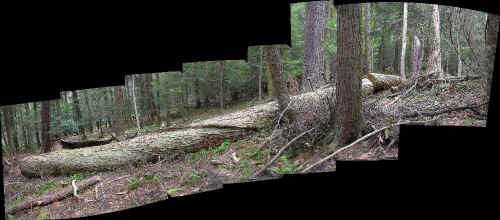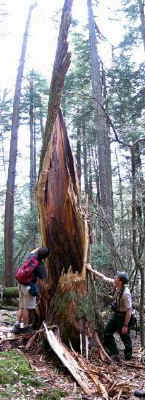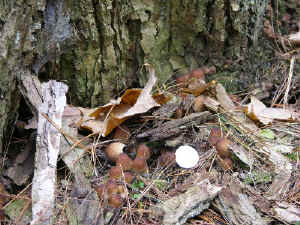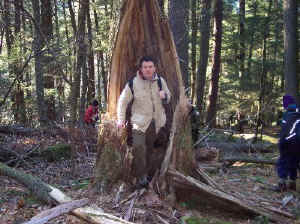| Cook
Forest Cucumber Tree
|
|
ENTS,
A large
cucumber tree located in Cook Forest near the intersection of
the Longfellow and Red Eft trails fell last winter. Dale
Luthringer with foresight ask the maintenance people to cut a
"cookie" - a cross-section of the trunk - as far
down the tree as possible above the hollow and decaying base of
the tree.

Pan of
fallen Cucumber tree in Cook Forest State Park- photo by Ed
Frank
The tree was
very old when it fell. Dale plans to sand the
cross-section and do a detailed ring count this winter. In
addition he plans to have the age confirmed by an expert in
dendrochronology. This project of Dale's has my full
support and that of ENTS as a whole. I have been
collecting related information about the tree before and after
it fell for incorporation into Dale Luthringer's research
results. The goal is to create a more detailed portrayal
of this particular cucumber tree.

Record cucumber tree Stump as seen during the spring
of 2005 -
photo submitted by Will Blozan |
The tree was
first measured in 1997 by Dr, Bob Van Pelt. The most recent
measurement prior to its fall was taken on 03/07/02 using ENTS laser-clinometer
techniques by Dale Luthringer. The tree measured 11.6 feet
cbh, and 111.2 feet in height. Dale has reported the tree began
to lean a couple of years ago and was held aloft by neighboring
pine trees - still alive, but already subject to trunk
failure. Last winter it finally fell. People who attended
the spring ENTS rendezvous at Cook Forest had the chance to see
the tree earlier this spring.
Ed
Frank Nov 24, 2005
|
|
Cook Forest cucumber tree |
Edward
Frank |
| Nov
21, 2005 07:29 PST |
| ENTS,
Friday I went to Cook Forest top look at the cucumber cookie
Dale had
collected from a large fallen Cucumber Tree. The tree is the
same one
pictured in a photo by Will Blozan from the spring Rendezvous.
Dale had
suggested in other communications that he tree was in excess of
300 years
old. Neil Pederson from EKU posted on the list last week
"The oldest
cucumber tree to date that I am familiar with is one I cored in
central
Virginia. Myvonwynn Hopton and I dated it to 348 years. This was
cored back
in 2003. So, it will be 350 years old today if it is still
alive." Based
upon looking at the tightness of the rings, the size of the
cookie, and some
preliminary counting I am convinced the tree is in excess of the
350 year
age. The cookie still needs to be sanded and polished, but that
is Dale's
plan for later this winter and I will leave that to him. I would
also like
to measure the widths of the individual rings to document the
history of the
tree.

Photo of the fallen cucumber tree - photo by Ed Frank |
Then Dale and I went to look at the fallen tree. It is
located near
the intersection of the Longfellow Trail and the Red Eft Trail.
He went
back to work and I stayed and measured circumferences/diameters
at various
points along the trunk to use to determine the volume of the
trunk of the
tree. I also took a number of photos as an initial starting
point to
document over time the various stages and organisms involved in
the eventual
decay of the fallen giant. It will be interesting if I can
return in ten
years and see how the fallen tree has fared over the years.

Fungus growing at the base of the fallen cucumber tree
at Cook Forest - photo by Ed Frank |
Does anyone have a photograph of the tree prior to its demise?
That evening Dale and I met up with Monica Jakuc and Bob
Leverett for dinner
at the Trails End Restaraunt - even if Bob doesn't remember my
name.
Unfortunately I had to work and missed the Saturday measuring
fest.
Ed Frank
|
| RE:
Cook Forest cucumber tree |
Robert
Leverett |
| Nov
21, 2005 09:48 PST |
Ed,
... Actually, I
was thinking about the age of the cucumber magnolia when I wrote
the
e-mail and wondered if we needed to inform Ed Cook at Lamont
Doherty
Earth Labs. With Neil Pederson now out in Kentucky, Ed's is the
name
that came first to my mind. We do have Dave Orwig at Harvard
Forest, and as
Dale has mentioned, Marc Abrams at Penn State. It is a tree that
deserves attention from the best. It also raises interesting
questions
about the ages of the oldest of other species in the forest
cathedral. I
have heard conflicting numbers on when that forest developed.

Anthony Kelly standing inside the hollow base of a
fallen 400+ year old cucumber tree in Cook Forest -
photo by Carl Harting Nov 19, 2005 |
I'll always be indebted to Ed Cook. He came to Wachusett Mtn in
1996
(I think it was then) at my invitation to look at the oaks and
other OG
on that mountain. He immediately recognized the northern red
oaks as the
oldest he'd seen in the Northeast. His knowledge is legendary.
He was
dating old growth white and chestnut oak along the crest of the
Blue
Ridge within spitting distance of the Blue Ridge Parkway when
the
Parkway hadn't the slightest idea that they had any old growth
beyond 3
or 4 places with big trees. In those days OG was still synonymous
with
old trees.
Another person who might like to know about
the age of the cucumber
tree is Charlie Cogbill an ecologist from Vermont and one of the
first
ecologists to propose a definition for OG. Charlie tracks
maximum
species ages when they have been verified. Charlie is still
listed as a
member of the ENTS list although we haven't heard from him in
ages.
I would bet that there is a scattering of very old trees in
Cook
Forest that predate all the dendro work that has been done to
date. What
the distribution would mean, I don't know. But I believe it is
there.
Bob
|
| RE:
Cook Forest cucumber tree |
djluth-@pennswoods.net |
|
Nov
21, 2005 07:45 PST |
Bob,
Thanks again for coming all the way over to Cook Forest.

"Cookie" from cucumber tree
|
That cuke' cross section is impressive. Because the base was
hollow the
"cookie" was taken at 22'2" up the trunk from its mid-slope
base. I counted 425,
427, and 433 rings, but I need to sand it down better. Maybe I
could
get Marc Abrams to take a run down to Cook sometime this winter
and take
a better look at it. I have a tough time determining false
rings, and
am not sure how prevalent cucumber magnolia are with this
phenomena.
Well Ed, you were right, it looks like I was a little too
conservative
on my earlier age estimate.
|
| RE:
Cook Forest cucumber tree |
djluth-@pennswoods.net |
| Nov
21, 2005 07:50 PST |
Ed Frank,
I've got a slide of that cuke' when it was standing. Next time
you're
over, stop by my office and I'll try to drum it up for you so
you can
scan it. The state hasn't allowed us to spend money on a decent
scanner
yet.
Yes, BVP measured it first, but that was back in 1997.
Dale
|
| Cucumber
Tree
ridge |
Will
Blozan |
| Tue, 22 Nov 2005 |
|

ED,
The ridge appears to be a fracture that severed the cambium. The spiral is
just the orientation of the wood fibers in the tree. Continued flexing along
the fracture does not allow the cambium to fuse together again into a
continuous layer across the fracture. Thus, the wound-wood tissue simply
"plows" into its respective counterpart on the other side of the fracture
and builds up a ridge of wood. This can also be seen when a tree tries to
swallow a rock. Sometimes these fractures do close again but the ridge will
remain for many years if not indefinitely. Regardless, the wood is fractured
underneath and trunk failure is likely.
Will
-----Original Message-----
From: Edward Frank
Sent: Monday, November 21, 2005 10:07 PM
Subject: RE: Cucumber
Will,
What is this ridge that spirals around the fallen cucumber tree? It is
about 3 inches high and an inch or so thick. See attached photo. Dale
said I should ask you.
Ed
|
| Re:
Cook Forest cooks EXCELLENT! |
John
A. Keslick, Jr. |
| Nov
22, 2005 11:16 PST |
If the cuc is not less than 450 increments then just think for a
minute.
Now the tree fell and we have a cuc nurse log. Unique!!!!!
Imagine this.
It took (just time along) over 450 years to manufacture this
nurse log.
What would the cost of a product be if it took over 450 years to
manufacture? I believe this nurse log is unique as well as
priceless.
Sincerely,
John A. Keslick, Jr.
http://mercury.ccil.org/~treeman/
|
| Re:
Cook Forest cooks EXCELLENT! |
Neil
Pederson |
| Nov
22, 2005 12:25 PST |
ENTS,
I was off list for a few days changing my subscription over to
my
EKU address and missed the old cucumber discussion.
It'd be awesome if the cucumber tree at Cook forest was more than
400
years. I'm sure they can probably live this long. I will, as
usual,
add a cautionary note. Crossdating cucumber trees [as well as
tulip-poplar and sweet birch] to obtain an exact age at coring
height
is tough. The ones I've worked with along the eastern US are
prone
to forming false rings. Locally absent rings are an occasional
problem, too. Myvonwynn Hopton and I had a heck of a time
crossdating
a few cucumber and tulip sites. In fact, we stopped trying to
crossdate a few cucumber trees because of false/missing rings.
For
example, one tree had ~18 extra bands on one side of the tree
versus
the other. We were not able to determine if missing rings or
false
rings caused this difference. It actual age is unknown.
Speaking of cukes, I stumbled on a large one 2'+ dbh [I had no
measuring equipment. I was just out on a pleasure hike], in
southern
Kentucky the other day. It is growing in a narrow canyon of
supposed
OG. There are some large trees in there that look old. I did
find,
however, a small road running halfway up the canyon. Hopefully
we'll
get some ages out of this place in the next year.
Neil
PS - Bob - Ed Cook did beat me to the oldest chestnut oak stand
in
the patch of OG I located by one measly year. That dude is
amazing. I
got my revenge, however, a year later when I tied his age for
chestnut oak in a stand he first sampled 20 yrs ago.
|
| Cooks
Cucumber Soil Test |
John
A. Keslick, Jr. |
| Nov
22, 2005 12:37 PST |
I tested the soil about the cucumber tree (with the help from
Dale) when it
was maintaining a symplast in an effort to understand optimum
fertility
levels for this species. The date was 1998.
The soil samples were taken in the upper four inches of the soil
where the
mycorrhizae would be and absorption would be taking place. We
did not test
inside nurse logs, but plenty of evidence shows that mycorrhizae
can be
found within decomposing wood.
At that time these organism, not limited to but including, were
present.
Magnolia acuminata 4' dbh est and largest standing found tree at
Cook. (
ground cover - eastern hemlock; sugar maple; eco-art nurse logs;
lady
ferns; violet; wood sorrel; lots of seedlings; birch; two
different ferns;
hairy cut moss; sphagnum moss; rocks.
Soil testing was done at Cornell.
(generally speaking more available elements can be found at
nurse logs.)
Our Test results
Lab ID #16922
(Pounds Per Acre PPA) Available
P = 7.4
K = 177
Mg = 149.5
Ca = 1266
AL = 66
Fe = 22.6
Mn = 229.5
Zn = 8.62
NO3-N = 20.41
Cu = 1.7
As you can see, many elements were not tested for.
Organic Matter % = 31.66
Ex acidity = 59.04 (ME / 100)
Salts mmho = 0.25 (mmho / cm)
ACID SOLUBLE (mg / Kg)
Cd = 0.98
Cu =7.39
Ni = 8.87
Mn = 1391.15
Co = 7.88
Zn = 168.53
Pb = 98.06
Cr = 15.76
P = 716.02
CARBON : NITROGEN
Moisture Content % 2.497
Nitrogen % = 0.94
Carbon % = 16.7
C:N Ratio 17.76:1
Thats all I have folks. This test was done to better understand
what proper
fertilization might be.
I do have other test results for old growth hemlock, white pine
and some
others.
Sincerely,
John A. Keslick, Jr.
|
| Re:
Cooks Cucumber Soil Test |
John
A. Keslick, Jr. |
| Nov
22, 2005 14:31 PST |
Bob
About the PPA numbers. I don't want to say it is conclusive,
however, I
have tested soil adjacent to nurse logs and then tested along
the edge where
material has collected and found that there was an increase in
available
essential elements at the nurse log.
I might get myself in trouble here. Let me take a risk.
The P was 7.4 PPA.
Now if I tested soil about 3 PPM at an urban Cucumber tree,
maybe the tree
would benefit by the addition of available P? It is
sophisticated. But
then what would the dose be?
But we must remember that a bag of fertilizer does not
contribute to the
extent of a nurse log and its processes of decomposition.
Maybe if we looked at the organic material content in the area.
Organic
Matter % = 31.66
One of the benefits of proper mulching maybe bringing the
Organic Matter
closer to 31.66% for cucumber trees?
Two things I forgot to include: pH was 3.81 and the altitude was
1500 -
1800 feet.
Micro elements (not miner, they are anything but miner) such as
calcium is
important too. 1266 PPM. We do know that nurse logs provide
calcium when
trees need it. So we may want to address calcium problems with
composted
wood chips and leaves and nurse logs????
We need more research on optimum fertility level for trees.
Sincerely,
John A. Keslick, Jr.
----- Original Message -----
From: "Robert Leverett"
Sent: Tuesday, November 22, 2005 4:27 PM
Subject: RE: Cooks Cucumber Soil Test
John,
Most interesting. Are there any surprises in the PPA numbers
below?
Any general conclusions?
Bob
|
| Re:
Questions to John Keslick |
Fores-@aol.com |
| Nov
23, 2005 09:52 PST |
John:
I think the "true" nurse logs like you describe are
far more rare outside of
protected circumstances than most people can imagine. There are
exceedingly
rare in parts of the Appalachians with a history of fire.
I think that the perched root systems of old black birch trees
that still
retain the shape of the stump they germinated on and grew around
is a testimony
to the decomposition process.
Part of what I do for a living involves manufacturing tree
stumps but I
enjoy watching the progress of the decomposition process. On my
parents farm in
Massachusetts there are massive while pine logs still lying
across the brook
as they were when I was a little kid almost 50 years ago and the
skeleton of
an old dead chestnut I sat beneath many times as I pondered my
future as a
forester has turned into a nearly unrecognizable pile of reddish
brown mush.
Russ Richardson |
| Re:
Cooks Cucumber Soil Test |
John
A. Keslick, Jr. |
| Nov
29, 2005 22:16 PST |
Dale
No it is PPA = Pounds Per Acre not PPM
[Editors Note: An acre
of mineral soil 6 to 7 inches deep weighs approximately 2
million
pounds. Therefore, to convert pounds per acre readings to parts
per million, divide by 2.]
Calcium
As of 11-29-2005 my numbers range is as follows.
290
410
552
570
594
661
670
896
902
979
1030
1266
1636
1783
1872
1936
2064
2208
2462
2559
2712
3128
3188
4034
4522
4523
4573
4605
4817
7417
8902
I will put together a list of test done and calcium results.
John
| |
John,
Did I understand your post below as the soil Ca
composition near the
Cook cuke' as 1,266 ppm? I'm more used to working with
this element in
aquatic environments. If I got this for a reading in any
NW PA stream,
I'd probably be thinking on the lines of 'who just
dumped lime in the
stream?!'. If this soil Calcium concentration is
correct, is this high
for soils? I'd normally expect an overall buffering
capacity of the
soils in Cook's conifer stands to be low due to the low
soil pH.
Dale |
|
| Re:
Cooks Cucumber Soil Test |
John
A. Keslick, Jr. |
| Nov
30, 2005 17:28 PST |
Results for Calcium
Optimum Soil Test
Allegany National Forest (Hearts Content) 3/4/1997
Hemlock, Pine, white
and beech which had low vitality in the area. Ferns and many
nurse logs and
moss to mention some. 3 different sites tested for Ca 290ppa -
410ppa -
670ppa
- - - - - - - - - -
Allegany National Forest(Tionesta Scenic area) 3/4/1997 Virgin
Old
growth blow down. From tornado in 1996 or 1997. In the tornado
swath of the
utility trail down the slope to the right. 4 sites tested. Ca
661ppa -
896ppa - 902ppa - 979ppa - 1636ppa.
Allegany National Forest(Tionesta Scenic area) 3/4/1997 Hemlock,
Pine, white and beech which had low vitality in the area. Ferns
and many
nurse logs and moss to mention some. This is from the area where
the resent
blow down occurred. 2 sites tested for Ca. Ca 570ppa - 1030ppa.
- - - - - - - - - - -
Adirondacks (Paul Smith College) NY. 3 test 9/8/1997
1. Eastern white pine, eastern hemlock and red spruce, primarily
conifer -
Ca was 1872ppa.
2. New growth primarily beech and most are root sprouts. Striped
maple and
red spruce coming up. The red spruce had waited for an opening
and now are
taking off. Primarily Hardwoods - Ca was 2064ppa.
3. Common wood ferns, hemlocks starting back, red spruce, yellow
birch,
beech, hemlock, real old growth yellow birch. Many nurse logs.
Hobble bush
which is primarily deer food. Shinning Club moss, primarily
hardwoods - Ca
was 2712ppa.
- - - - - - - - - - - -
Last 40 at Dora Lake (Last 40 acres old growth.). In Minnesota.
White pine
and red pine so says the sign; young balsam furs, black spruce
(some),
clubmoss (species?).
No date? 1 test Ca was 1783ppa.
- - - - - - - - - - - - - -
Pioneers Mothers Memorial Forest. Hoosier National Forest Paoli
Indiana.
10/13/1997
1.. White oak, other oak (red or black?), Young Sugar Maples. Ca
2559ppa.
2.. White oak (maturing); shag bark hickories and some maples..
Ca
2208ppa.
3.. White oak, (black or red oak?), shag bark hickory; younger
maples
understory. Ca 2462ppa.
4.. White oak, shag bark hickory, oak with leaves like chestnut
oak but
outer bark looked like white oak and some maples (black or red
oak?). Ca
4034ppa
5.. White oak, beeches, understory and over story maples, no
shag bark
hickory. Ca 4523ppa.
6.. Beech and maple. Ca 4573ppa.
7.. Black walnut lots of understory and some maples in low
area.3.5-4' dia
black walnut. Ca 7417ppa.
8.. Black walnut, tulip poplars in area, yellow popular lots of
understory
and some maples in low area.3' dia black walnut. Ca 4817ppa.
Eco-art nurse log test in same area.
Not at E.A. Nurse Log. Ca 3128ppa.
Just under E.A. Nurse Log. Ca 8902ppa.
- - - - - - - - - - - - - - -
Spring Mill State Park - Donaldson's Woods
Nature Preserve Virgin Timber
Mitchell Indiana. 10/12/1997
1.. White oak, shag bark hickory, mature tulip poplars and dog
wood,
Cornus florida, there was chestnut and chinkopin oak in the
preserve. Ca
4522ppa.
2.. White oak, shag bark hickory, tulip poplar, understory
beech, sugar
maples understory, some dog woods - Cornus florida avg. 1"
dbh just a few
producing seeds. Ca 4605ppa.
- - - - - - - - - - - - - - - -
Joyce Kilmore Wilderness Trails Nantahala National Forest Virgin
Old
Growth w/traffic 11/13/1997
1.. Cucumber Magnolia, acuminata; Tulip Poplars - Yellow Poplars
4-5'
dbh.; understory maple coming up; ferns; rock, some understory
hemlock. Ca
1936ppa.
2.. Tulip Poplars - Yellow Poplars 4-5' dbh.; understory maple,
1 beech,
small hemlocks in understory. Ca 3188ppa.
3.. Mountain Magnolia, (NOTE may be large leaf - PSU) Magnolia
Fraseri
averg. 1.5' or smaller dbh but 30-40' tall and clumps with
included bark. ;
Rhododendron; hemlock up hill; maples; mountain laurel. Ca
552ppa.
- - - - - - - - - - - - - - - -
Cook State Forest Park 8/30/1998 Magnolia acuminata 4' dbh est
and largest
standing found tree at Cook. ( ground cover - eastern hemlock;
sugar maple;
eco-art nurse logs; lady ferns; violet; wood sorrel; lots of
seedlings;
birch; two different ferns; hairy cut moss; sphagnum moss;
rocks. Ca
1266ppa.
John |
| calcium
levels and tree species |
Robyn
Darbyshire |
| Dec
02, 2005 00:16 PST |
This may have been mentioned somewhere along the line in these
posts, so
forgive me if I'm repeating something...(topica only puts ENTS
mail in
my inbox sporadically, so I have to read it all briefly
online....).
Some tree species, such as dogwood, cedars (Cupressaceae), and
hardwoods
in general are known to take up higher amounts of calcium and
store (and
recycle) it in their foliage vs. other species. There are
several
articles in the literature related to this. It is interesting to
take a
look at John's calcium sampling results and compare it to the
species
present, and see that this may explain some of the different
results on
the different sites. |
| Re:
Cooks Cucumber Soil Test |
John
A. Keslick, Jr. |
| Jan
20, 2006 20:01 PST |
Charlie and Dale
Lets take it one test site at a time.
Dale please replace the record on the soil test with this one.
Please let
me know you made the change.
I took ten samples with a teaspoon from the area where the
non-woody
absorbing roots were. I mixed the sample in a clean bag and sent
in for
testing.
Cucumber Tree Site At Cook State Park Forest.
Moisture content % 2.497
P, available mg/Kg 7.4
K, available mg/Kg 177
Mg, available mg/Kg 149.5
Ca, available mg/Kg 1266
Fe, available mg/Kg 22.6
Al, available mg/Kg 66.0
Mn, available mg/Kg 229.5
Zn, available mg/Kg 8.62
Cu, available mg/Kg 1.7
pH in water pH 3.81
Exchange Acidity coml./kg
59.04
LOI, (Organic Matter)% 31.66
NO3, available mg/Kg 20.41
B, Water soluble mg/Kg Not
Determined
Soluble salts mmho 0.25
Cd, acid-soluble mg/Kg 0.98
Cu, acid-soluble mg/Kg 7.39
Ni, acid-soluble mg/Kg 8.87
Mn, acid-soluble mg/Kg 1391.15
Co, acid-soluble mg/Kg 7.88
Zn, acid-soluble mg/Kg 168.53
Pb, acid-soluble mg/Kg 98.06
Cr, acid-soluble mg/Kg 15.76
P, acid-soluble mg/Kg 716.02
N, total % 0.94
C, total % 16.70
John |
|